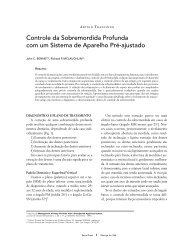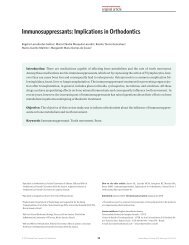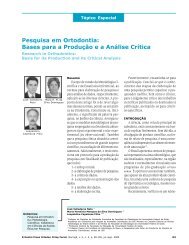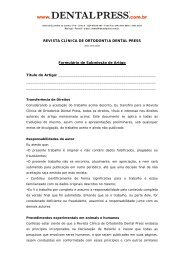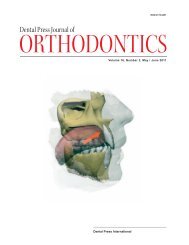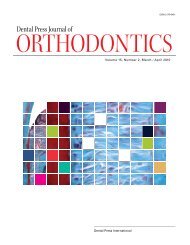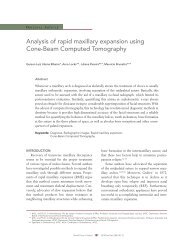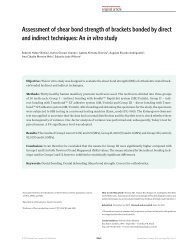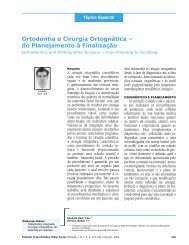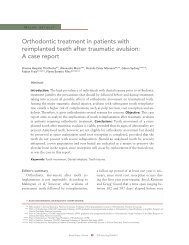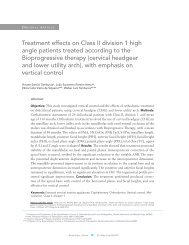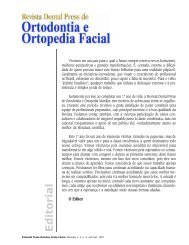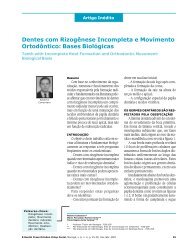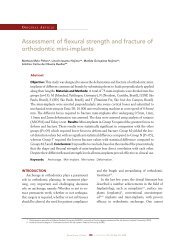Dental Press
Dental Press
Dental Press
You also want an ePaper? Increase the reach of your titles
YUMPU automatically turns print PDFs into web optimized ePapers that Google loves.
[ original article ] SEM and microbiological analysis of dirt of endodontic files after clinical use and its influence on sterilization processa glass tube containing BHI (Brain Heart Infusion, Himedia,Curitiba, PR, Brazil). Then it was removed andplaced in a test tube containing thioglycolate broth(Himedia, Curitiba, PR, Brazil). As a negative control,two tubes of BHI liquid and thioglycolate were used.These tubes didn’t receive samples. The positivecontrol was performed by inoculating strains of periodontalpathogens from clinical specimens and isolatesof Enterococcus spp. The tubes were incubatedin a microbiological stove, in the presence of oxygenat 37°C for 72 hours. The presence of microorganismswas confirmed by observing turbidity of the liquidculture medium after 24, 48 and 72 hours. Thenegative samples were those which do not lead tochange in the culture medium, whereas the positivesamples were those that caused the turbidity of it.To prove the sterility of files, after observingthe presence or absence of turbidity in liquid media,was made the inoculation in solid medium. A10µl aliquot of BHI was inoculated on the surfaceof the culture medium (agar plain), allowed to dryand incubated aerobically at 37ºC. The same procedurewas performed with sodium thioglycolate, butthe plates were incubated in microaerophilic by themethod of the candle flame.ResultsThe results showed that in group 1 the endodonticfiles showed different degrees of dirt after performingthe same cleaning protocol (Fig 1) providing, in mostcases, a surface with large quantities of waste, representedby score 4 (Graph 1).Moreover, the results didn’t show presence ofbacterial growth on the surface of endodontic files for24, 48 and 72 hours after incubation, both in BHI andin thioglycolate medium, except the positive controlwhere there was the presence of growth bacteria inall periods of compliance and in both culture media(Graphs 2 and 3).DiscussionThe endodontic instruments are used to removethe remnants of pulp tissue during the procedures ofcleaning and shaping of the root canal system. Theseinstruments are submitted by a cleaning process beforesterilization to be reused, with the aim of removalof organic matter and waste tissue in the instruments.ACDFigure 1. Scores for determining the amount of dirt on the surface ofendodontic files: A) Score 1 - no residues in the file; B) Score 2 - filealmost clean surface, i.e., presenting a small quantity of waste; C) Score3 - surface of the file with an average amount of waste and, D) Score4 - surface of the file with a large amount of waste.876543210Graph 1. Assessment of the degree of contamination of endodontic files.2520151050Graph 2. Presence / absence of bacterial growth on the surface ofendodontic files in culture media BHI/Time.2520151050Score 1BHI (-) BHI (+)TGC (-) TGC (+)Graph 3. Presence / absence of bacterial growth on the surface ofendodontic files in culture media Thioglycolate TGC/Time.BScore 2 Score 3 Score 424 hours 48 hours 72 hours24 hours 48 hours 72 hours© 2011 <strong>Dental</strong> <strong>Press</strong> Endodontics 84<strong>Dental</strong> <strong>Press</strong> Endod. 2011 apr-june;1(1):82-6



